How Rising Water Levels Altered Ecosystem Provisioning Services of the Area around Qinghai Lake from 2000 to 2020: An InVEST-RF-GTWR Combined Method
Abstract
:1. Introduction
2. Materials and Methods
2.1. Study Area
2.2. Ecosystem Provisioning Services Assessment
2.2.1. Water Yield
2.2.2. Soil Conservation
2.2.3. Habitat Quality
2.3. Random Forest
2.4. The Geographically and Temporally Weighted Regression Model
2.5. Data Sources
3. Result
3.1. Temporal Changes of Ecosystem Provisioning Services around Qinghai Lake
3.2. Spatial Changes in Ecosystem Provisioning Services around Qinghai Lake
3.3. Changes in Ecosystem Provisioning Services in Different Land Use Types
4. Discussion
4.1. Trade-Off and Synchrony among Ecosystem Provisioning Services
4.2. Trade-Off and Synchrony of Ecosystem Provisioning Services in Different Land Types
4.3. Influencing Factors of Ecosystem Provisioning Services
4.4. Spatial Differentiation of Driving Factors of Ecosystem Provisioning Services
4.5. Reliability and Limitation
5. Conclusions
Author Contributions
Funding
Institutional Review Board Statement
Informed Consent Statement
Data Availability Statement
Conflicts of Interest
Appendix A
| Land Use Types | Description |
|---|---|
| Cultivated land | It refers to the land for planting crops, including mature cultivated land, newly opened wasteland, leisure land, rotation land, and grass field rotation land. Agricultural fruit, mulberry, and forestry land mainly for planting crops. Beaches and tidal flats that have been cultivated for more than three years. |
| Woodland | It refers to the forest land for growing trees, shrubs, open woodlands, nurseries, and various gardens. |
| Grassland | It refers to all kinds of grasslands mainly growing herbaceous plants with a coverage of more than 5%, including shrub grassland dominated by grazing and open forest grassland with a canopy density of less than 10%. |
| Waters | It refers to the natural land water area and the land for water conservancy facilities, including rivers, lakes, reservoirs, ponds, and beaches. |
| Built-up land | It refers to urban and rural residential areas, factories, and mines independent of cities and towns, large industrial areas, quarries, traffic roads, and special land. |
| Unused land | It refers to currently unused land, including hard-to-use land, sandy land, Gobi, saline-alkali land, bare land, etc. |
| Correlation Coefficient | Trade-Off and Synchrony |
|---|---|
| 0.7~1 | Strong synchrony |
| 0.3~0.7 | Medium synchrony |
| 0~0.3 | Weak synchrony |
| 0 | No correlation |
| −0.3~0 | Weak trade-off |
| −0.7~−0.3 | Medium trade-off |
| −1~−0.7 | Strong trade-off |
References
- Verpoorter, C.; Kutser, T.; Seekell, D.A.; Tranvik, L.J. A global inventory of lakes based on high-resolution satellite imagery. Geophys. Res. Lett. 2014, 41, 6396–6402. [Google Scholar] [CrossRef]
- Wang, J.; Song, C.; Reager, J.T.; Yao, F.; Famiglietti, J.S.; Sheng, Y.; MacDonald, G.M.; Brun, F.; Schmied, H.M.; Marston, R.A.; et al. Recent global decline in endorheic basin water storages. Nat. Geosci. 2018, 11, 926–932. [Google Scholar] [CrossRef]
- Alsdorf, D.E.; Rodríguez, E.L.; Lettenmaier, D.P. Measuring surface water from space. Rev. Geophys. 2007, 45, RG2002. [Google Scholar] [CrossRef]
- Costanza, R.; Arge, R.; Groot, R.D.; Farber, S.; Grasso, M.; Hannon, B.; Limburg, K.; Naeem, S.; Neill, R.V.; Paruelo, J.; et al. The value of the world’s ecosystem services and natural capital. Nature 1997, 387, 253–260. [Google Scholar] [CrossRef]
- Vitousek, P.M.; Mooney, H.A.; Lubchenco, J.; Melillo, J.M. Human Domination of Earth’s Ecosystems. Science 1997, 277, 494–499. [Google Scholar] [CrossRef]
- Su, X.; Bo, Z.; Huang, W.; Su, X.; Lei, S. Effects of the Three Gorges Dam on preupland and preriparian drawdown zones vegetation in the upper watershed of the Yangtze River, P.R. China. Ecol. Eng. 2012, 44, 123–127. [Google Scholar] [CrossRef]
- Qi, Y.; Lian, X.; Wang, H.; Zhang, J.; Yang, R. Dynamic mechanism between human activities and ecosystem services: A case study of Qinghai Lake watershed, China. Ecol. Indic. 2020, 117, 106528. [Google Scholar] [CrossRef]
- Gu, X.; Long, A.; Liu, G.; Yu, J.; Wang, H.; Yang, Y.; Zhang, P. Changes in ecosystem service value in the 1 km lakeshore zone of Poyang Lake from 1980 to 2020. Land 2021, 10, 951. [Google Scholar]
- Paterson, A.M.; Rühland, K.M.; Anstey, C.V.; Smol, J.P. Climate as a driver of increasing algal production in lake of the woods, Ontario, Canada. Lake Reserv. Manag. 2017, 33, 403–414. [Google Scholar] [CrossRef]
- Yang, G.; Zhang, Q.; Wan, R.; Lai, X.; Jiang, X.; Li, L.; Dai, H.; Lei, G.; Chen, J.; Lu, Y. Lake hydrology, water quality and ecology impacts of altered river-lake interactions: Advances in research on the middle Yangtze river. Hydrol. Res. 2016, 47, 1–7. [Google Scholar] [CrossRef]
- Mekuria, W.; Diyasa, M.; Tengberg, A.; Haileslassie, A. Effects of long-term land use and land cover changes on ecosystem service values: An example from the Central Rift Valley, Ethiopia. Land 2021, 10, 1373. [Google Scholar] [CrossRef]
- Lavorel, S.; Grigulis, K.; Lamarque, P.; Colace, M.P.; Garden, D.; Girel, J.; Pellet, G.; Douzet, R. Using plant functional traits to understand landscape distribution of multiple ecosystem services. J. Appl. Ecol. 2011, 99, 135–147. [Google Scholar] [CrossRef]
- Chapin, F.S.; Matson, P.A.; Mooney, H.A. Principles of Terrestrial Ecosystem Ecology; Springer: New York, NY, USA, 2011. [Google Scholar]
- Darvill, R.; Lindo, Z. The inclusion of stakeholders and cultural ecosystem services in land management trade-off decisions using an ecosystem services approach. Landsc. Ecol. 2016, 31, 533–545. [Google Scholar] [CrossRef]
- Millennium Ecosystem Assessment. Ecosystems and Human Well-Being: Synthesis; Island Press: Washington, DC, USA, 2005. [Google Scholar]
- Angradi, T.R.; Launspach, J.J.; Bolgrien, D.W.; Bellinger, B.J.; Starry, M.A.; Hoffman, J.C.; Trebitz, A.S.; Sierszen, M.E.; Hollenhorst, T.P. Mapping ecosystem service indicators in a Great Lakes estuarine Area of Concern. J. Great Lakes Res. 2016, 42, 717–727. [Google Scholar] [CrossRef]
- Cui, L. Evaluation of functions of Poyang Lake ecosystem. Chin. J. Ecol. 2004, 23, 47–51. [Google Scholar]
- Schirpke, U.; Tasser, E.; Leitinger, G.; Tappeiner, U. Using the ecosystem services concept to assess transformation of agricultural landscapes in the European Alps. Land 2022, 11, 49. [Google Scholar] [CrossRef]
- Shui, W.; Wu, K.; Du, Y.; Yang, H. The trade-Offs between supply and demand dynamics of ecosystem services in the bay areas of Metropolitan regions: A case study in Quanzhou, China. Land 2022, 11, 22. [Google Scholar] [CrossRef]
- Sharma, B.; Rasul, G.; Chettri, N. The economic value of wetland ecosystem services: Evidence from the Koshi Tappu Wildlife Reserve, Nepal. Ecosyst. Serv. 2015, 12, 84–93. [Google Scholar] [CrossRef]
- Greenland-Smith, S.; Brazner, J.; Sherren, K. Farmer perceptions of wetlands and waterbodies: Using social metrics as an alternative to ecosystem service valuation. Ecol. Econ. 2016, 126, 58–69. [Google Scholar] [CrossRef]
- Wondie, A. Ecological conditions and ecosystem services of wetlands in the Lake Tana Area, Ethiopia. Ecohydrol. Hydrobiol. 2018, 18, 231–244. [Google Scholar] [CrossRef]
- Li, M.; Zhou, Y.; Xiao, P.; Tian, Y.; Huang, H.; Xiao, L. Evolution of Habitat Quality and Its Topographic Gradient Effect in Northwest Hubei Province from 2000 to 2020 Based on the InVEST Model. Land 2021, 10, 857. [Google Scholar] [CrossRef]
- Qiao, M.; Liu, K.; Gao, Y.; Ying, L.; Fan, Y.; Chao, G. Assessment on social values of ecosystem services in Xi’an Chanba national wetland park based on Solves Model. Wetl. Sci. 2018, 16, 51–58. [Google Scholar]
- Xu, X.; Bo, J.; Yan, T.; Robert, C.; Yang, G. Lake-wetland ecosystem services modeling and valuation: Progress, gaps and future directions. Ecosyst. Serv. 2018, 33, 19–28. [Google Scholar] [CrossRef]
- Schallenberg, M.; de Winton, M.D.d.; Kelly, D.J.; Hamill, K.D.; Verburg, P. Ecosystem services of lakes. In Ecosystem Services in New Zealand: Conditions and Trends; Dymond, J.R., Ed.; Manaaki Whenua Press: Lincoln, NE, USA, 2013; pp. 203–225. [Google Scholar]
- Reynaud, A.; Lanzanova, D. A global meta-analysis of the value of ecosystem services provided by lakes. Ecol. Econ. 2017, 137, 184–194. [Google Scholar] [CrossRef]
- Liu, H.; Yin, J.; Lin, M.; Chen, X. Sustainable development evaluation of the Poyang Lake Basin based on ecological service value and structure analysis. Acta Ecol. Sin. 2017, 37, 2575–2587. [Google Scholar]
- Yang, W.; Jin, Y.; Sun, T.; Yang, Z.; Cai, Y.; Yi, Y. Trade-offs among ecosystem services in coastal wetlands under the effects of reclamation activities. Ecol. Indic. 2018, 92, 354–366. [Google Scholar] [CrossRef]
- Chen, X.; Wang, X.; Feng, X.; Zhang, X.; Luo, G. Ecosystem service trade-off and synergy on Qinghai-Tibet Plateau. Geogr. Res. 2021, 40, 18–34. [Google Scholar]
- Lei, Y.; Yang, K.; Wang, B.; Sheng, Y.; Bird, B.W.; Zhang, G.; Tian, L. Response of inland lake dynamics over the Tibetan Plateau to climate change. Clim. Change 2014, 125, 281–290. [Google Scholar] [CrossRef]
- Li, L.; Shen, H.; Liu, C.; Jiao, R. Response of water level fluctuation to climate warming and wetting scenarios and its mechanism on Qinghai Lake. Clim. Chang. Res. 2020, 16, 600–608. [Google Scholar]
- Zhou, D.; Zhang, J.; Luo, J.; Guo, G.; Li, B. Analysis on the causes of Qinghai Lake water level changes and prediction of its future trends. Ecol. Environ. Sci. 2021, 30, 1482–1491. [Google Scholar]
- Chang, B.; He, K.; Li, R.; Sheng, Z.; Wang, H. Linkage of Climatic Factors and Human Activities with Water Level Fluctuations in Qinghai Lake in the Northeastern Tibetan Plateau, China. Water 2017, 9, 552–564. [Google Scholar] [CrossRef]
- Ji, J.; Shen, J.; Balsam, W.; Chen, J.; Liu, L.; Liu, X. Asian monsoon oscillations in the northeastern Qinghai-Tibet Plateau since the late glacial as interpreted from visible reflectance of Qinghai Lake sediments. Earth Planet. Sci. Lett. 2005, 233, 61–70. [Google Scholar] [CrossRef]
- Luo, C.; Xu, C.; Liu, H.; Jin, S. Analysis on grassland degradation in Qinghai Lake Basin During 2000–2010. Acta Ecol. Sin. 2013, 33, 4450–4459. [Google Scholar]
- Cui, B.; Li, X. Stable isotopes reveal sources of precipitation in the Qinghai Lake Basin of the northeastern Tibetan Plateau. Sci. Total Environ. 2015, 527–528, 26–37. [Google Scholar] [CrossRef]
- Dong, H.; Song, Y.; Zhang, M. Hydrological trend of Qinghai Lake over the last 60 years: Driven by climate variations orhuman activities? J. Water Clim. Chang. 2019, 10, 524–534. [Google Scholar] [CrossRef]
- Wang, R.; Shao, T.; Wei, P. Enrichment content and ecological risk assessment of heavy metal in surface soil around Qinghai Lake. Arid. Zone Res. 2021, 38, 411–420. [Google Scholar]
- Zhang, L.; Hickel, K.; Dawes, W.R.; Chiew, F.H.S.; Western, A.W.; Briggs, P.R. A rational function approach for estimating mean annual evapotranspiration. Water Resour. Res. 2004, 40, 1–14. [Google Scholar] [CrossRef]
- Donohue, R.J.; Roderick, M.L.; McVicar, T.R. Roots, storms and soil pores: Incorporating key ecohydrological processes into Budyko’s hydrological model. J. Hydrol. 2012, 436–437, 35–50. [Google Scholar] [CrossRef]
- Wischmeier, W.H.; Smith, D.D. Predicting Rainfall Erosion Losses: A Guide to Conservation Planning, Agriculture Handbook No. 537; US Department of Agriculture Science and Education Administration: Washington, DC, USA, 1978. [Google Scholar]
- Cai, C.; Ding, S.; Shi, Z.; Huang, L.; Zhang, G. Study of applying USLE and geographical information system IDRISI to predict soil erosion in small watershed. J. Soil Water Conserv. 2000, 14, 19–24. [Google Scholar]
- Breiman, L. Random Forests Machine Learning. J. Clin. Microbiol. 2001, 2, 199–228. [Google Scholar]
- Duan, Q.; Luo, L. A Dataset of Human Footprint Over the Qinghai-Tibet Plateau During 1990–2017; National Tibetan Plateau Data Center: Beijing, China, 2021. [Google Scholar]
- Cui, L.; Chen, P.; Zhang, H.; Dong, W.; Huang, J. Soil Erosion by Wind in Aibi Lake and Surrounding Areas Based on QuickBird Image. Bull. Soil Water Conserv. 2013, 33, 60–63. [Google Scholar]
- Cheng, J.; Liu, C.; Liu, K.; Wu, J.; Fan, C.; Xue, B.; Ma, R.; Song, C. Potential impact of the dramatical expansion of Lake Qinghai on the habitat facilities and grassland since 2004. J. Lake Sci. 2021, 33, 922–934. [Google Scholar]
- Wu, H.; Chen, Y. Estimation of lake water storage change of Qinghai Lake based on the ICESat satellite altimetry data and Landsat satellite imageries. J. Water Resour. Water Eng. 2020, 31, 7–15. [Google Scholar]
- Zheng, H.; Ouyang, Z.; Zhao, T.; Li, Z.; Xu, W. The impact of human activities on ecosystem services. J. Nat. Resour. 2003, 18, 118–126. [Google Scholar]
- Li, S.; Zhang, Y.; Wang, Z.; Li, L. Mapping human influence intensity in the Tibetan plateau for ecological service functions. Ecosyst. Serv. 2018, 30, 276–286. [Google Scholar] [CrossRef]
- Li, X.; Yu, X.; Wu, K.; Feng, Z.; Liu, Y.; Li, X. Land-use zoning management to protecting the Regional Key Ecosystem Services: A case study in the city belt along the Chaobai River, China. Sci. Total Environ. 2020, 762, 143–167. [Google Scholar] [CrossRef]
- Yang, D.; Liu, W.; Tang, L.; Chen, L.; Li, X.; Xu, X. Estimation of water provision services for monsoon catchments of South China: Applicability of the InVEST model. Landsc. Urban Plan. 2019, 182, 133–143. [Google Scholar] [CrossRef]
- Jiang, B.; Zhang, L.; Ouyang, Z. Ecosystem services valuation of Qinghai Lake. Chin. J. Appl. Ecol. 2015, 26, 3137–3144. [Google Scholar]
- Li, H.; Zhang, A.; Gao, Z.; Zhou, M. Quantitative analysis of the impacts of climate and socio-economic driving factors of land use Change on the ecosystem services value in the Qinghai Lake area. Prog. Geogr. 2012, 31, 1747–1754. [Google Scholar]
- Chen, K.; Li, S.; Zhou, Q.; Duo, H.; Chen, Q. Analyzing dynamics of ecosystem service values based on variations of landscape patterns in Qinghai Lake area in recent 25 years. Resour. Sci. 2008, 2, 274–280. [Google Scholar]
- Yin, L.; Wang, X.; Zhang, K.; Xiao, F.; Cheng, C.; Zhang, X. Trade-offs and synergy between ecosystem services in National Barrier Zone. Geogr. Res. 2019, 38, 2162–2172. [Google Scholar]
- Dallimer, M.; Davies, Z.G.; Diaz-Porras, D.F.; Irvine, K.N.; Maltby, L.; Warren, P.H.; Armsworth, P.R.; Gaston, K.J. Historical influences on the current provision of multiple ecosystem services. Glob. Environ. Chang. 2015, 31, 307–317. [Google Scholar] [CrossRef]
- Han, Y. Impacts of Changes in Climate and Landscape Patterns on Ecosystem Services in the Qinghai Lake Basin; Qinghai Normal University: Xining, China, 2021. [Google Scholar]
- Lian, X.; Qi, Y.; Wang, H.; Zhang, J.; Yang, R. Spatial pattern of ecosystem services under the influence of human activities in Qinghai Lake watershed. J. Glaciol. Geocryol. 2019, 41, 1254–1263. [Google Scholar]
- Bennett, E.M.; Peterson, G.D.; Gordon, L.J. Understanding relationships among multiple ecosystem services. Ecol. Lett. 2009, 12, 1394–1404. [Google Scholar] [CrossRef]


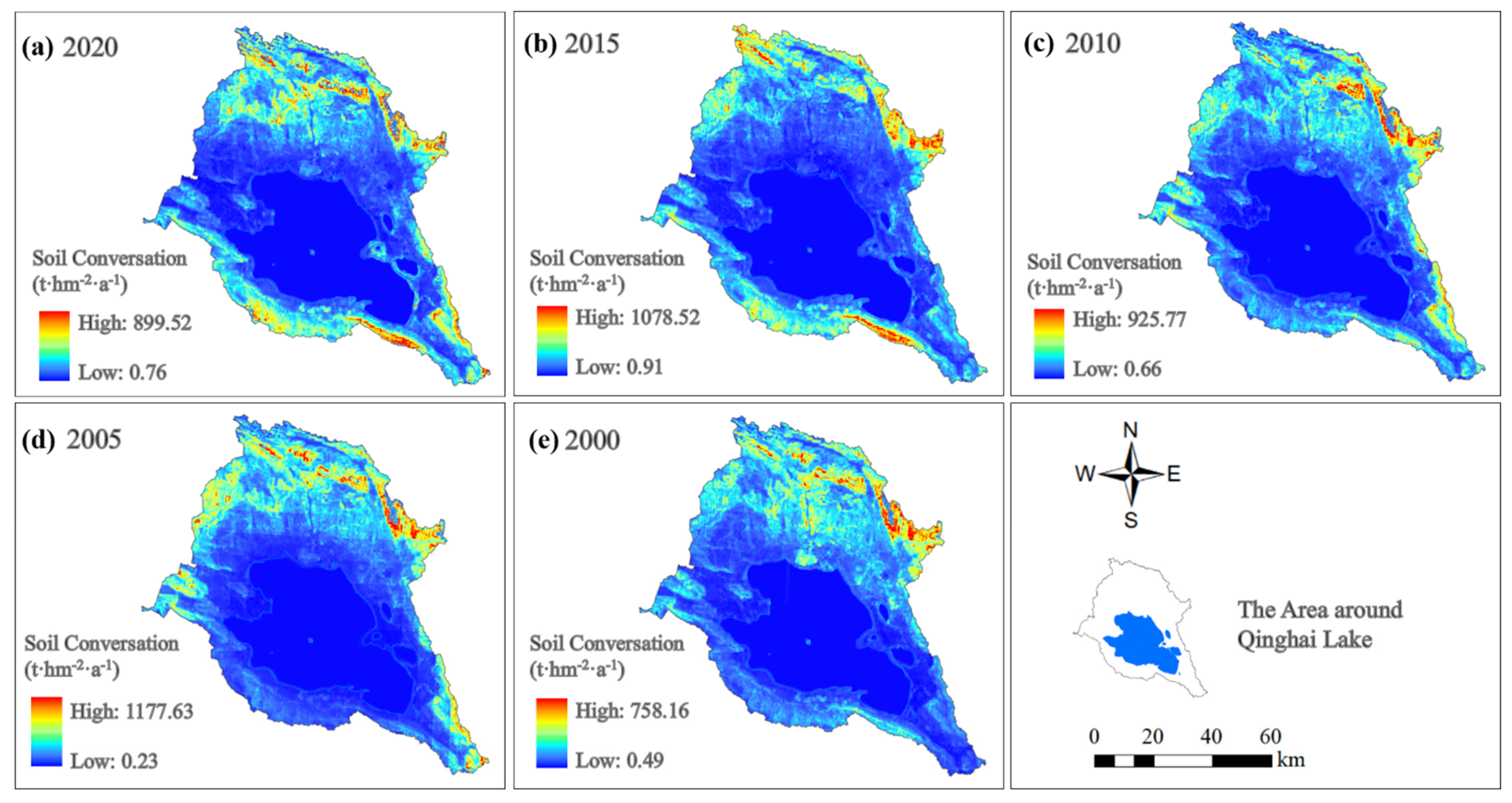
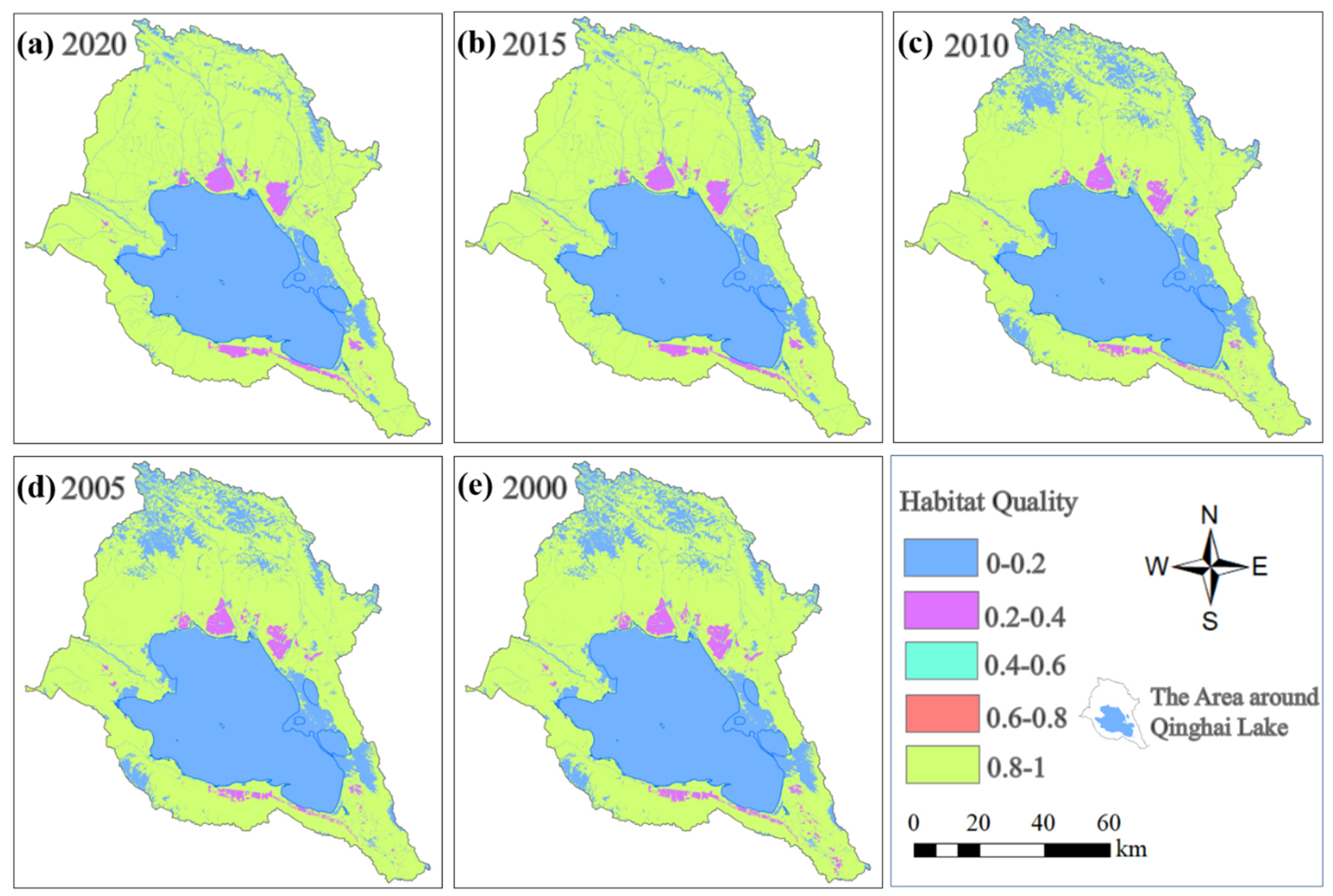
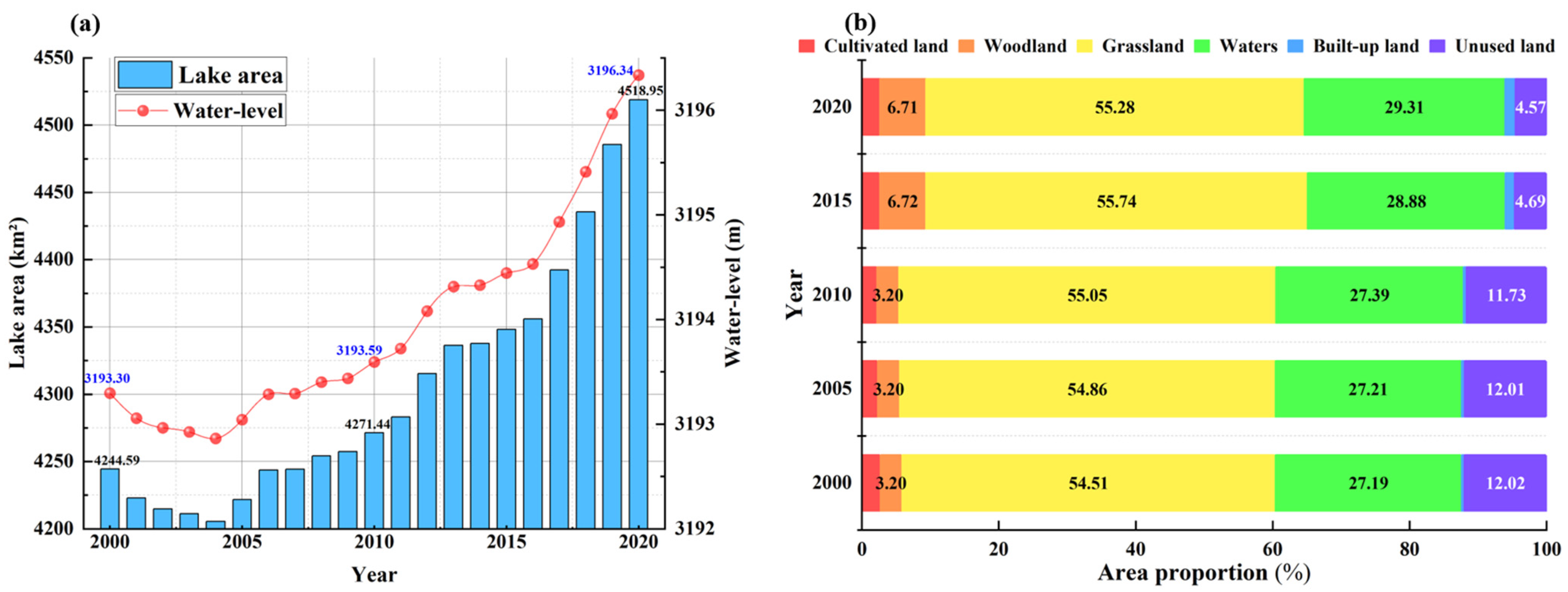

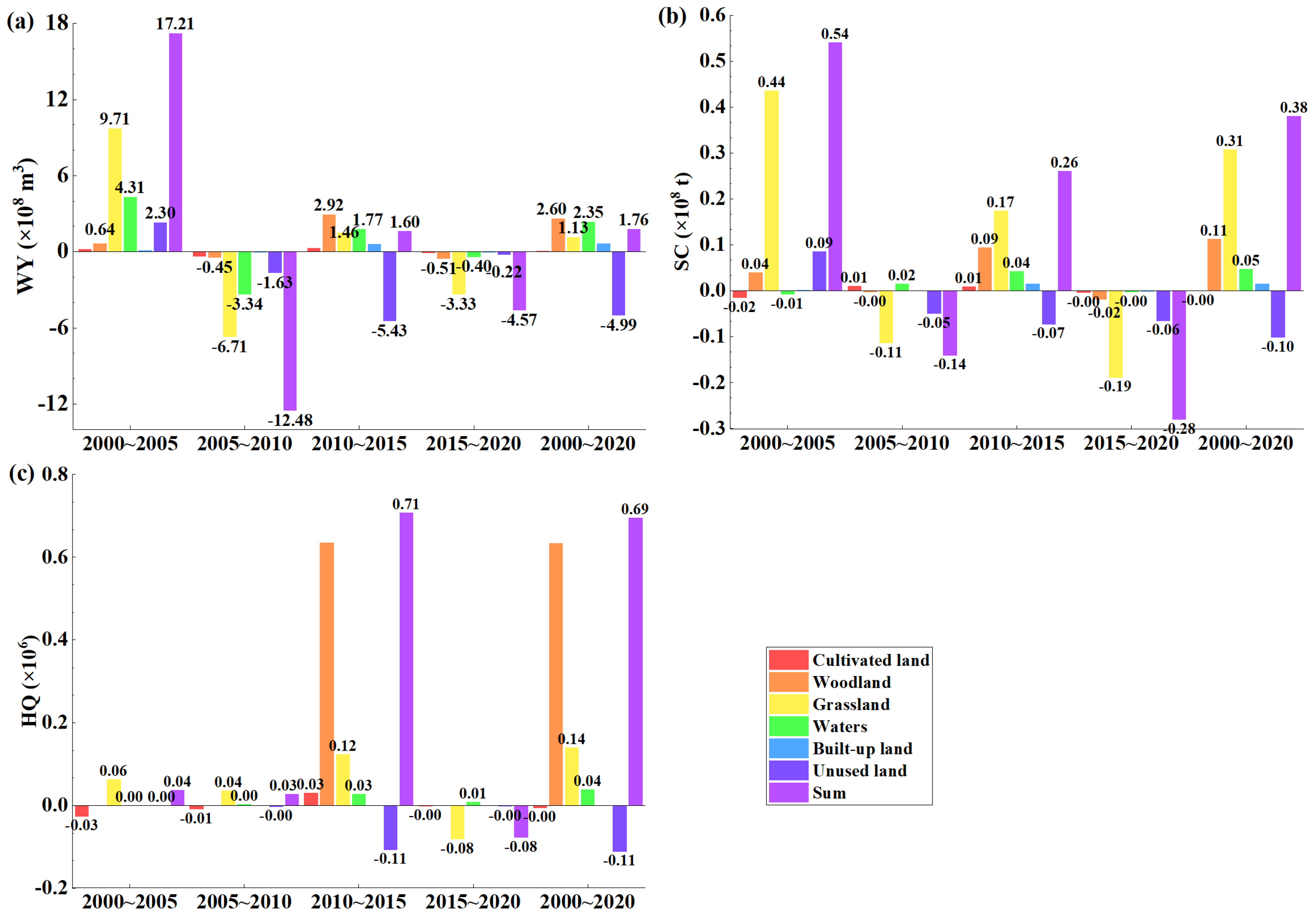
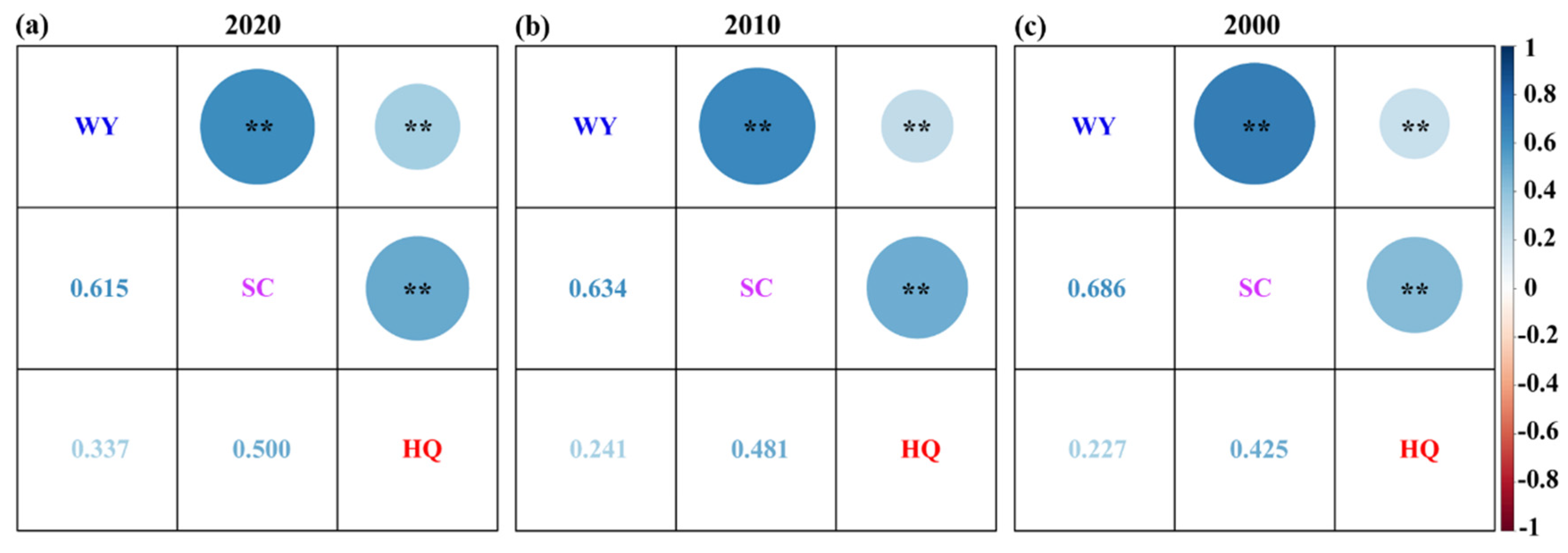
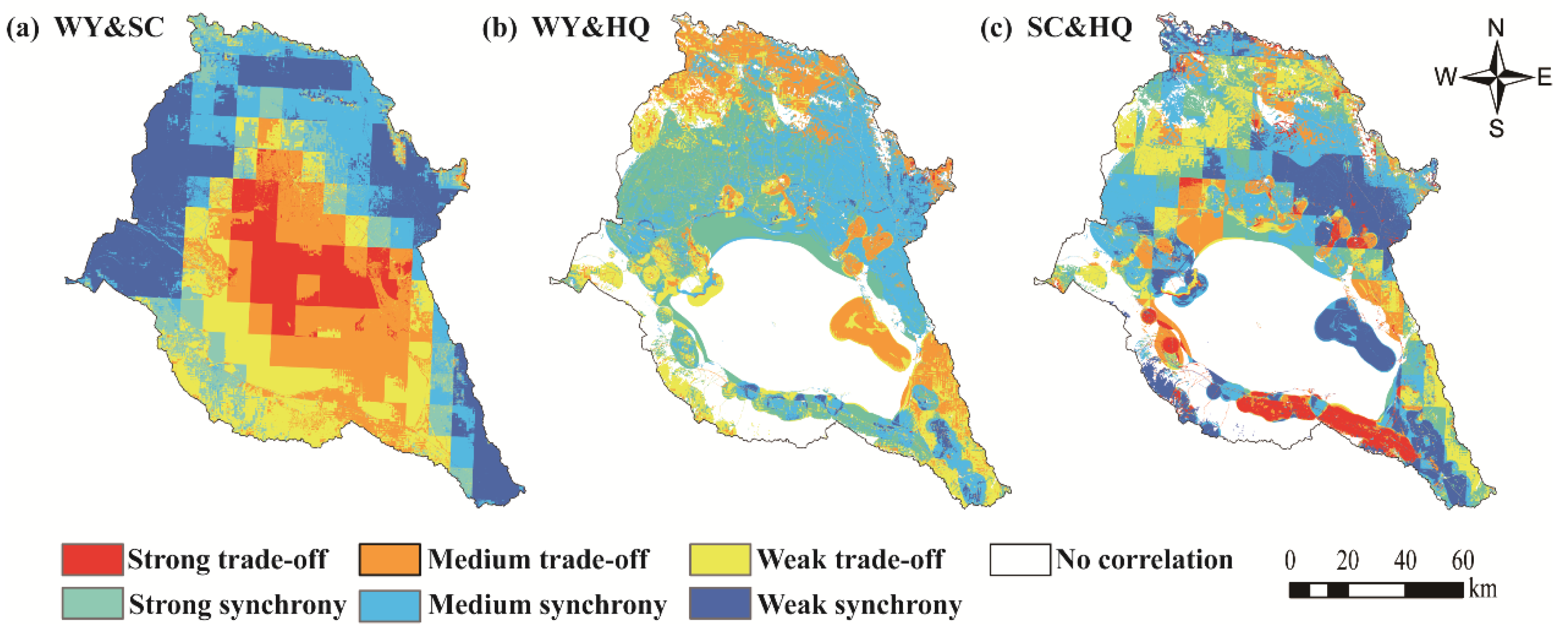



| Data Type | Unit | Resolution/Scale | Data Sources |
|---|---|---|---|
| Monthly precipitation | mm | 1 km | http://data.cma.cn (accessed on 28 August 2021) |
| Average monthly temperature | °C | 1 km | http://data.cma.cn (accessed on 28 August 2021) |
| Evapotranspiration | mm | 500 m | https://ladsweb.modaps.eosdis.nasa.gov (accessed on 28 August 2021) |
| Normalized Difference Vegetation Index | / | 250 m | https://lpdaas.usgs.gov (accessed on 28 August 2021) |
| Digital Elevation | m | 30 m | Shuttle Radar Topography Mission |
| Soil texture | % | 1 km | Harmonized World Soil Database |
| Soil organic matter | % | 1 km | Harmonized World Soil Database |
| Soil bulk density | g·cm−3 | 1 km | Harmonized World Soil Database |
| Land-Use and Land-Cover Change | / | Type Value | Remote sensing interpretation |
| Gross Domestic Product | Ten thousand yuan /km2 | 1 km | http://www.resdc.cn/data (accessed on 7 May 2021) |
| Population Density | Person/km2 | 1 km | http://www.resdc.cn/data (accessed on 7 May 2021) |
| Human Footprint | / | 1 km | https://data.tpdc.ac.cn/ (accessed on 7 May 2021) |
| Year | Ecosystem Services Per Unit Area | Total Ecosystem Services | ||||
|---|---|---|---|---|---|---|
| WY (mm) | SC (t·hm−2·a−1) | HQ | WY (×108 m3) | SC (×108 t) | HQ (×106) | |
| 2020 | 349.27 | 271.82 | 0.66 | 56.55 | 1.58 | 11.93 |
| 2015 | 377.51 | 341.89 | 0.67 | 61.12 | 1.86 | 12.00 |
| 2010 | 367.60 | 285.84 | 0.63 | 59.52 | 1.60 | 11.30 |
| 2005 | 444.68 | 331.39 | 0.63 | 72.00 | 1.74 | 11.27 |
| 2000 | 338.40 | 230.05 | 0.62 | 54.79 | 1.20 | 11.23 |
| 2015–2020 | Cultivated Land | Woodland | Grassland | Waters | Built-Up Land | Unused Land | Loss-2015 |
|---|---|---|---|---|---|---|---|
| Cultivated land | 0.03 | 3.87 | 0.35 | 6.41 | 0.01 | 10.67 | |
| Woodland | 0.05 | 52.92 | 4.02 | 1.18 | 2.01 | 60.18 | |
| Grassland | 4.86 | 54.08 | 77.22 | 58.16 | 18.13 | 212.45 | |
| Waters | 0.02 | 2.59 | 22.71 | 1.26 | 5.32 | 31.89 | |
| Built-up land | 3.58 | 0.95 | 42.10 | 1.35 | 0.26 | 48.24 | |
| Unused land | 0.02 | 2.13 | 20.86 | 18.88 | 0.48 | 42.37 | |
| Gain-2015 | 8.53 | 59.78 | 142.45 | 101.82 | 67.49 | 25.72 | 405.81 |
| Net changes | −2.14 | −0.40 | −69.99 | 69.93 | 19.25 | −16.65 |
Publisher’s Note: MDPI stays neutral with regard to jurisdictional claims in published maps and institutional affiliations. |
© 2022 by the authors. Licensee MDPI, Basel, Switzerland. This article is an open access article distributed under the terms and conditions of the Creative Commons Attribution (CC BY) license (https://creativecommons.org/licenses/by/4.0/).
Share and Cite
Wang, L.; Mao, X.; Song, X.; Tang, W.; Wang, W.; Yu, H.; Deng, Y.; Zhang, Z.; Zhang, Z.; Zhou, H. How Rising Water Levels Altered Ecosystem Provisioning Services of the Area around Qinghai Lake from 2000 to 2020: An InVEST-RF-GTWR Combined Method. Land 2022, 11, 1570. https://doi.org/10.3390/land11091570
Wang L, Mao X, Song X, Tang W, Wang W, Yu H, Deng Y, Zhang Z, Zhang Z, Zhou H. How Rising Water Levels Altered Ecosystem Provisioning Services of the Area around Qinghai Lake from 2000 to 2020: An InVEST-RF-GTWR Combined Method. Land. 2022; 11(9):1570. https://doi.org/10.3390/land11091570
Chicago/Turabian StyleWang, Lei, Xufeng Mao, Xiuhua Song, Wenjia Tang, Wenying Wang, Hongyan Yu, Yanfang Deng, Ziping Zhang, Zhijun Zhang, and Huakun Zhou. 2022. "How Rising Water Levels Altered Ecosystem Provisioning Services of the Area around Qinghai Lake from 2000 to 2020: An InVEST-RF-GTWR Combined Method" Land 11, no. 9: 1570. https://doi.org/10.3390/land11091570








